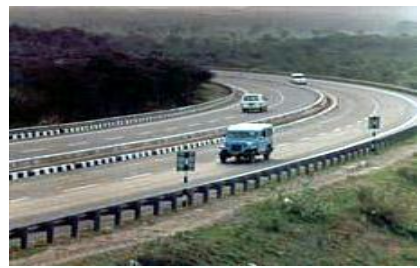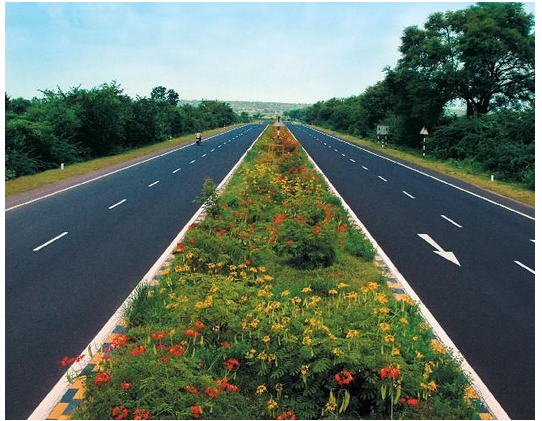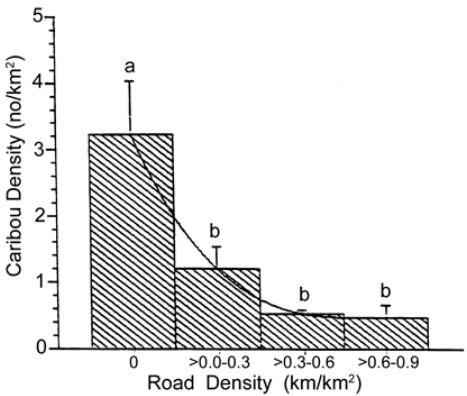Roadways
Lifeline Of National Economy of Class 10
India has one of the largest road networks in the world, aggregating to about 2.3 million km at present. In India, roadways have preceded railways. They still have an edge over railways in view of the ease with which they can be built and maintained.
IMPORTANCE OF ROAD TRANSPORT VIS-A-VIS RAIL TRANSPORT:
- construction cost of roads is much lower than that of railway lines,
- roads can traverse comparatively more dissected and undulating topography,
- roads can negotiate higher gradients of slopes and as such can traverse mountains such as the Himalayas,
- road transport is economical intransportation of few persons and relatively smaller amount of goods over short distances,
- it also provides door-to-door service, thus the cost of loading and unloading is much lower
- road transport is also used as a feeder to other modes of transport such as they provide a link between railway stations, air and sea ports.
In India, roads are classified in the following six classes according to their capacity.
GOLDEN QUADRILATERAL:
The government has launched a major road development project linking Delhi-Kolkata- Chennai-Mumbai and Delhi by six-lane Super Highways. The North-South corridors linking Srinagar (Jammu & Kashmir) and Kanyakumari (Tamil Nadu), and East-West Corridor connecting Silcher (Assam) and Porbander (Gujarat) are part of this project. The major objective of these Super Highways is to reduce the time and distance between the mega cities of India. These highway projects are being implemented by the National Highway Authority of India (NHAI).

Delhi-Jaipur Highway
NATIONAL HIGHWAYS:
National Highways link extreme parts of the country. These are the primary road systems and are laid and maintained by the Central Public Works Department (CPWD). A number of major National Highways run in North-South and East-West directions.

STATE HIGHWAYS:
Roads linking a state capital with different district headquarters are known as State Highways. These roads are constructed and maintained by the State Public Works Department (PWD) in State and Union Territories.
DISTRICT ROADS:
These roads connect the district headquarters with other places of the district. These roads are maintained by the Zila Parishad.
VILLAGE ROADS:
- Rural roads, which link rural areas and villages with towns, are classified under this category.
- These roads received specials impetus under the Pradhan Mantri Grameen Sadak Yojana.
- Under this scheme special provisions are made so that every village in the country is linked to a major town in the country by an all season motorable road.
- These roads open the rural economy for the urban economy.
- These roads connect one village to another.
BORDER ROADS:
Border Road Organisation a Government of India undertaking constrructs and maintains roads in the bordering areas of the country. This organisation was established in 1960 for the development of roads of strategic importance in the northern and north-eastem border areas. These roads have improved accessibility in areas of difficult terrain and have helped in the economic development of these areas.
The another classification can be done on the basis of type of material used for building roads.
|
S.No. |
Surfaced road |
Unsurfaced road |
|
1. |
Metalled roads built of coal tar, cement and stone. |
Unmetalled roads made of loose soils & stone |
|
2. |
Smooth and polished roads. |
Rugged and dusty roads. |
|
3. |
All weather roads. |
Seasonal roads which turn into mud during the rainy season. |
|
4. |
Constructed and maintained by state and central government. |
Constructed and maintained by local authourities village panchayats etc. |
|
5. |
53% of the total road network. |
47% of the total road network. |
ROAD DENSITY:
The length of road per 100 sq. km of area is known as density of roads. Distribution of road is not uniform in the country. Density of all roads varies from only 10 km in Jammu & Kashmir to 375 km in Kerala with the national average of 75 km (1996-97).

PROBLEMS OF ROAD TRANSPORT:
- The road network is inadequate.
- Half of the roads are unsurfaced which become muddy during the rainy season.
- National highways are inadequate, highly congested in cities, their bridges and culverts are narrow.
- Road side amenities like telephone booths, books, emergency with services and police protection are poor, needs improvement.









